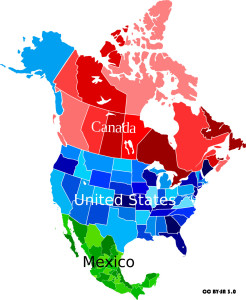
The central obligation of international trade law is non-discrimination. For example, under the General Agreement on Tariffs and Trade, commonly known as the GATT, nations are required to treat foreign products as favorably as they treat domestic products. Article 24 of the GATT, however, allows nations who have formed free trade areas to favor the products of the acceding nations Certain sectors of the trade community are concerned that expanded trade under regional free trade agreements weakens the international trading system. Despite these concerns, and with the emergence of rival trading blocs, a more integrated European Community, and the possible Association of Southeast Asian Nations (AS BAN) free trade area, the United States has pursued a policy of bilateral and regional free trade.
Most recently, the United States has pursued this policy by entering into the North American Free Trade Agreement (NAFTA)
with its neighbors, Canada and Mexico. The creation of a North American free trade area, extending from the polar extremes of the Yukon to the coral reefs of the Yucatan, has proven to be extremely contentious. Although trade agreements have historically engendered lively debates (because various sectors of the participating nations’ economies profit more than others from such agreements), NAFTA has proven uniquely difficult. The debate over the approval of NAFTA has, for the first time, linked expanded free trade with social ramifications attendant to trade (i.e., environmental impact). While critics are concerned with a wide range of social issues in regard to NAFTA, their principal social concerns fall into two spheres: labor concerns and environmental concerns.’ This article provides a discussion of NAFTA as it relates to these two spheres of concern.
/wp-content/uploads/2015/08/IntegratingLabor_1993.pdf
